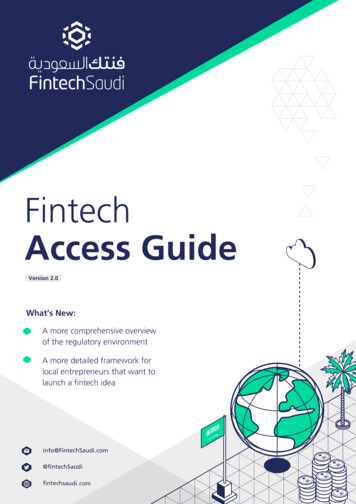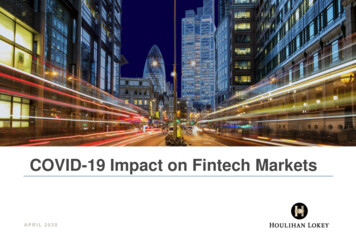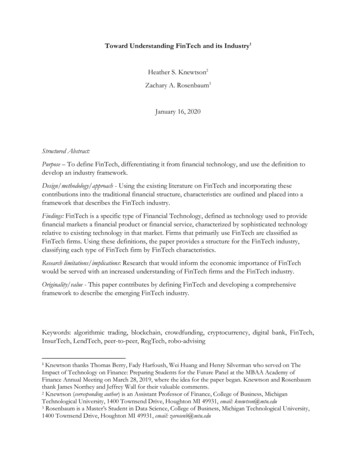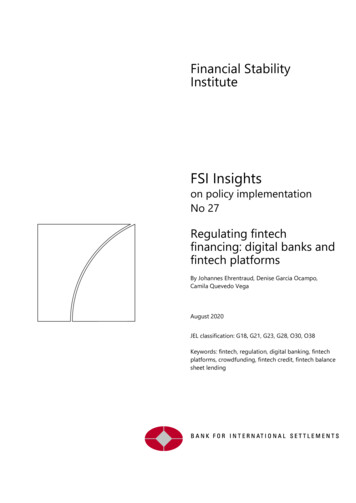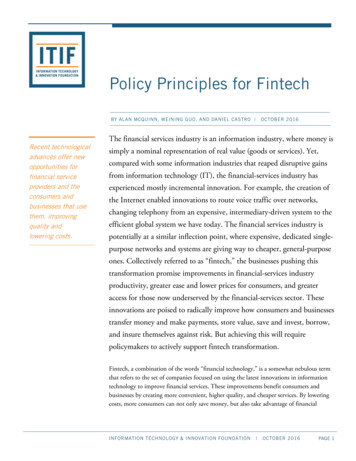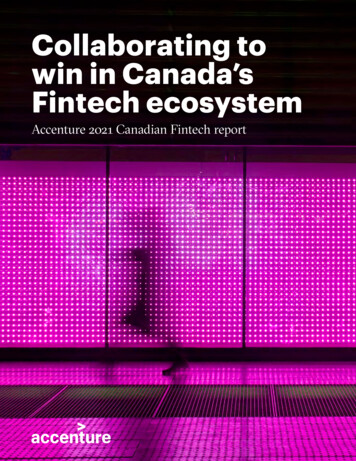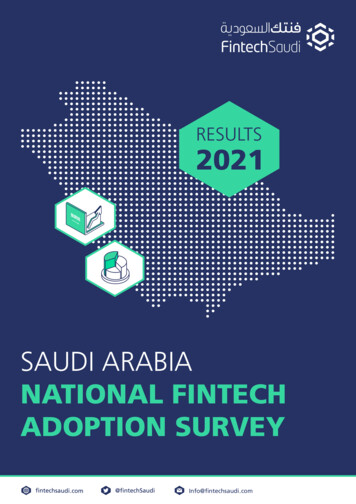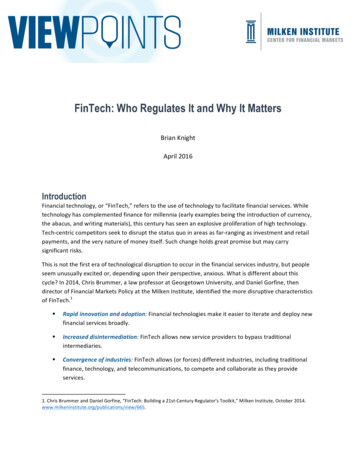
Transcription
FinTech: Who Regulates It and Why It MattersBrian KnightApril 2016IntroductionFinancial technology, or “FinTech,” refers to the use of technology to facilitate financial services. Whiletechnology has complemented finance for millennia (early examples being the introduction of currency,the abacus, and writing materials), this century has seen an explosive proliferation of high technology.Tech-centric competitors seek to disrupt the status quo in areas as far-ranging as investment and retailpayments, and the very nature of money itself. Such change holds great promise but may carrysignificant risks.This is not the first era of technological disruption to occur in the financial services industry, but peopleseem unusually excited or, depending upon their perspective, anxious. What is different about thiscycle? In 2014, Chris Brummer, a law professor at Georgetown University, and Daniel Gorfine, thendirector of Financial Markets Policy at the Milken Institute, identified the more disruptive characteristicsof FinTech.1!Rapid innovation and adoption: Financial technologies make it easier to iterate and deploy newfinancial services broadly.!Increased disintermediation: FinTech allows new service providers to bypass traditionalintermediaries.!Convergence of industries: FinTech allows (or forces) different industries, including traditionalfinance, technology, and telecommunications, to compete and collaborate as they provideservices.1. Chris Brummer and Daniel Gorfine, “FinTech: Building a 21st-Century Regulator’s Toolkit,” Milken Institute, October .
!Lower costs/fewer barriers to entry: The decreasing costs of technology allow smallercompanies to prototype and deploy services that were previously too capital intensive.!Borderless platforms: The use of technology, especially the Internet, reduces or eliminates thecosts of geographic distance, allowing service providers the capability (if not the legal right) tooffer financial services globally.!Democratization of opportunity: Lower costs and greater scalability allow for the wideavailability of services that were once prohibitively expensive or scarce.In June 2015, a participant at a Milken Institute roundtable explained the ongoing regulatory uncertaintywith the following points:2!Powerful, inexpensive, “customer-facing” technologies, such as those found in smartphones, areexpanding potential market size for services that were once prohibitively expensive for all butthe very wealthy; groups that previously could not access or afford these products and servicesmay be less sophisticated than traditional customers.!FinTech innovation is cutting across regulatory jurisdictions because different business modelsor delivery methods for services do not conform to existing regulatory structures.!Technology eliminates the distance barrier and allows competitors to offer products to newmarkets on national and global levels. This can put pressure on regulatory systems that assumea material geographic limitation.!Regulators are seeing entrants to markets who lack the traditional backgrounds and world viewstypically associated with incumbents, calling into question regulators’ own traditionalassumptions about market participants and practices.!Regulators contend with the increasing pace of innovation as technology enables faster iterationand experimentation of financial services and products.These themes become evident when one considers some of the most prolific FinTech innovations. Nonbank marketplace lending, for example, disintermediates banks by matching borrowers and lendersworldwide. Mobile payment services accelerate the pace of payments relative to traditional services andallow transactions to take place by means of a phone whose computing power used to be prohibitivelyexpensive for all but large institutions.In addition, companies can use sophisticated and self-improving algorithms to parse copious amounts ofdata to inform investment and lending decisions, enabling those who were previously unable to bescored for credit to gain access to it. Perhaps the most potentially disruptive innovation is the rise ofvirtual currency. While it has uses for traditional financial services, it also presents the potential tocompete with government-backed currencies in the global economy.2. The roundtable, “FinTech: Innovation and Regulation,” was a closed-door session held June 25, 2015, in Washington, DC, andattended by regulators, academics, lawyers, and FinTech companies.2
Financial services is not the only industry to see many of these dynamics play out, but it is one of themost comprehensively regulated industries, and technology is straining its existing regulatoryframework. For example, the inherent scope of Internet-enabled lending and payment systems ischallenging assumptions about whether a company should be regulated primarily at the federal or statelevel. Likewise, regulators who used to rely on intermediaries, like broker-dealers, as points of controlare finding those intermediaries bypassed by new players.3 Even basic assumptions about the regulatoryprocess, and how quickly the regulatory decision loop takes, are being challenged as financial serviceschange and proliferate far more quickly than new rules are written.These pressures may necessitate significant changes to financial regulation. While non-bank lending, forexample, has been primarily regulated at the state level, the inherently interstate nature of onlinemarketplace lending may justify federal preemption of state regulations in order to provide a consistentregulatory environment. Additionally, if the pace of innovation and complexity of the technologyprevent regulators from creating adequate rules-based regulations, they may consider moving to moreprinciples-based rules.4 Finally, regulators may find that the rules created to benefit consumers are infact counterproductive if they prevent entry by startups who may lack the resources to meet significantcompliance burdens and who, by innovative competition, could serve as an effective means ofregulating market participant behavior.Given the very real potential for significant change in both the financial and regulatory systems, it isimportant for stakeholders—elected officials, regulators, and market participants—to evaluate whetherthe current regulatory system is adequate or in need of reform. The Milken Institute Center for FinancialMarket’s FinTech Program, recognizing the vital importance of a financial system that is innovative,dynamic, inclusive, and that provides adequate protection against fraud and misuse, seeks to helpinform this discussion through research, analysis, and forums with leading stakeholders in the space.What follows is an analysis on one of the most important questions regarding FinTech regulation: Whoshould regulate?This paper seeks to examine the implications of that question, and how the answer may affect bothcompany and consumer use of financial services. Given the scope and diversity of FinTech, the paper’srepresentation of the regulatory environment is by necessity simplified and does not purport to providespecific answers. Instead, it seeks to offer general points that stakeholders may wish to consider. It willbriefly discuss the underlying purpose of regulation and then highlight three dynamics that affect theregulation of FinTech—the differences between government, private, and market regulators; the issuessurrounding various levels of governmental regulation; and the impacts of having multiple regulatoryagencies within a government overseeing different aspects of a transaction. It will close with somegeneral recommendations for how the question should be evaluated.3. For a thorough treatment of this dynamic in the securities industry, see Chris Brummer, “Disruptive Technology andSecurities Regulation,” Fordham Law Review 84, 977 (2015), http://ir.lawnet.fordham.edu/flr/vol84/iss3/6.4. For a discussion of the costs and benefits of principle-, rule-, and performance-based regulations, see Brummer and Gorfine,pp. 6 8.3
What is Regulation?It is important, and surprisingly difficult, to explain what we mean by “regulation.” While regulation isgenerally considered the purview of government, with legislatures and administrative agenciesestablishing statutes or administrative rules that have the force of law, other powerful forces andplayers are also able to influence the actions of individuals and companies in the FinTech space. Forexample, non-governmental self-regulatory organizations (SROs) can create rules and enforce disciplinein certain industries; companies can be constrained by contract and litigation; and market competitioncan enforce unwritten standards of service on pain of bankruptcy. Voters and policymakers alike shouldunderstand these non-governmental effects, which will be influenced as well by any law, rule, orenforcement action.This paper uses a broad definition of regulation, and of who or what counts as a regulator:Regulations are rules (whether enshrined in official law, found in private contract, or enforced by themarket) that govern how an activity is conducted, and provide a means of redress or enforcement ifthe rules are violated. Regulators are any actors who enforce those rules.Regulation can be roughly divided into two parts—the creation and promulgation of a rule; and theenforcement of a rule. In cases like formal legislation or administrative rulemaking, the creation,promulgation, and enforcement of a rule is highly formalized, with explicit procedures (e.g., a noticeand-comment period, passage of a law by Congress, or formal trial or administrative proceeding). Inother cases the creation and enforcement may be more subtle and informal (e.g., the creation of acontract between two private parties or competition forcing certain behavior to maintain customers).What Purpose Does Regulation Serve?Having defined (for the purposes of this paper) what regulation is, it is worth asking why regulation isnecessary. While opinions among convening participants differed about the scope of regulation, itsform, and who should regulate, there was consensus that some amount of regulation is essential tofunctional markets for financial services. Among the reasons:!The need for orderly and reliable markets to attract customers and provide certainty tomarket actors: A market that lacks intelligible rules, and fails to provide a reasonable belief thatthose rules can be relied on and enforced, is unlikely to survive. Likewise, entrepreneurs are lesslikely to enter a market if they are unsure what the rules are and whether their rights will beenforced.!Provision of a means of redress: The provision of a mechanism for redress, particularly forconsumers and/or small businesses to limit the risk they face from bad actors (as opposed tomarket risk), is also vital to obtaining sufficient buy-in.!A level playing field: Firms want to trust that their competition will be held to similar rules, andthat bad actors will be punished, before allocating resources to a market.4
!Systemic security: Transactions or products that are not threatening in themselves may, in theaggregate, pose a risk to third parties or the broader economy. Regulations help limit the riskand potential spread of such risk.!Law enforcement: Transactions may pose a risk outside the financial system. For example, antimoney-laundering/combating the financing of terrorism (AML/CFT) regulations seek to preventcriminal and terrorist organizations from using the financial system, even if their transactions donot pose risks to the parties to the transactions or to the broader health of the financial system.Who Regulates, and Why Does It Matter?The question of who will regulate is both important and challenging. Different types of regulators havedifferent levels of authority, procedures, means of enforcement, and jurisdictions. They also tend tooperate at different speeds and may possess different levels of sophistication. Finally, the number ofregulators with which a market participant must deal can significantly affect the regulatory burden.These differences of type, speed, and number can be relevant to questions about which regulator is bestsuited to address a particular issue.Types of RegulatorsBecause of the scope, scale, and dynamism of FinTech, the sector is often regulated by multipleregulators, both within certain types (e.g., multiple government regulators) and across types (e.g.,governmental, self-regulators, and market regulators).1. Government regulators: The government is what most people think of when they think of aregulator. While elected governments can regulate an industry or activity directly via legislation, theyfrequently empower a regulatory agency to create and enforce rules. Legislation may set theagency’s jurisdiction (though its jurisdiction may be ill or broadly defined), structure, and procedures.A particular agency may have exclusive authority over an industry, or there may be multiple agencieswith overlapping authority. The US federal system means there may be state and federal regulatorsoverseeing the same issues at their respective levels. Additionally, government may enter intointernational agreements to harmonize regulations and create international agencies capable ofresponding to multinational entities and cross-border transactions. This can provide greaterconsistency for international markets but add additional layers of cost and complexity.Regulatory agencies generally promulgate regulations via a notice-and-comment process that allowsthe public to review a proposed rule for a period of time and provide feedback. Agencies may holdopen meetings on a proposed regulation to receive additional public (including industry) input. Theagency is required to consider the feedback as it finalizes the rule. This process provides broaddemocratic access but can be time consuming and taxing on regulator resources.5 Additionally, the5. For example, it took the Securities and Exchange Commission three and a half years to finalize Title III, RegulationCrowdfunding, after the passage of the Jumpstart Our Business Startups (JOBS) Act in April 2012.5
regulation may be at risk of becoming obsolete due to rapidly innovating technologies or changingmarket conditions.6Once regulations are finalized, agencies can provide guidance to market participants on areas ofambiguity via various formal and informal means, including no-action letters (negotiated letters thatlay out a set of facts where the agency staff would not recommend an enforcement action);“frequently asked questions” guidance; and public statements. Additionally, regulators can createspecific programs in which they make themselves available for questions from companies andprovide non-binding guidance, or even create regulatory “sandboxes,” where entrepreneurs can tryinnovative business models under the regulator’s guidance. Examples include the Consumer FinancialProtection Bureau’s (CFPB) Project Catalyst7 and the Financial Conduct Authority’s (FCA) ProjectInnovate in the United Kingdom.8In some cases, such as bank regulation, regulators may conduct ongoing inspections of marketparticipants to ensure compliance and prevent problems from developing. These inspections are notin response to alleged violations but are designed to protect the stability of the market and ensurecompliance by regulated entities.9Government regulatory enforcement actions can involve administrative or judicial proceedings, andrequire set processes, usually including the ability to present evidence and a right to appeal adecision. In some cases, the government may pursue criminal convictions. These proceedings tend tobe relatively slow-moving, although agencies will often enter into agreements with the party againstwhom they have brought the enforcement action, and will assess some sort of penalty stipulatingthat the targeted party will change its behavior.Enforcement actions may serve as an example to firms in the same industry. While theseenforcement actions can provide necessary correctives, there is also a concern that agencies may usethem to coerce changes in behavior that should properly stem from formal changes in the rules.10While regulation via agency is the most obvious version of government regulation, the governmentalso serves as a regulator via the judicial system, which allows private parties to assert claims againsteach other and enforce the resulting judgments.6. Rule 504 of Regulation D under the Securities Act of 1933, for example, limits the size of an offering a company can raiseannually to 1 million. Inflation has eroded that value, leading the SEC to propose raising the amount to 5 million. Because thischange requires a modification to Regulation D, the SEC must undertake a new notice-and-comment period.7. Consumer Financial Protection Bureau, www.consumerfinance.gov/projectcatalyst/.8. Financial Conduct Authority, https://innovate.fca.org.uk/.9. See, for example, Federal Deposit Insurance Corporation, “Basic Examination Concepts and Guidelines,” RMS Manual ofExamination Policies, Section 1.1, p. 2. pdf.10. See, for example, Rachel Witkowski, “How CFPB Reshapes Market with Enforcement Actions—Not Rules,”American Banker, posted online February 1, 2016. s-1079137-1.html.6
Private actors also serve as significant regulators via contracts, as will be discussed later. Thesecontracts are ultimately adjudicated and enforced through the judicial system. Likewise, common-lawobligations, like the duty of care, are enforced via the courts.Benefits and costs of government regulation: Government regulation can be the most powerful formof regulation. First, it can invoke the power of the state and impose penalties ranging from monetaryfines on up to imprisonment. Second, it has the ability to regulate an entire industry directly andproactively, while many forms of private regulation tend to be responsive and firm specific. Finally, itincorporates the views of the broadest spectrum of stakeholders, both directly, through thesolicitation and consideration of public comment, and indirectly, through elections. This transparencyand inclusiveness can provide a broad foundation for legitimacy.Government regulation is not without costs, however. It tends to be the slowest model to adapt tochanges in the market and among regulated actors because of process requirements, leading to ahigher risk of rules becoming obsolete. In the need to address new developments, governments mayfail to make changes to old rulemaking, thus leaving in place legacy regulatory frameworks that areinsufficient or incompatible with the products and services offered by firms in the 21st century.Additionally, regulators’ broad jurisdictions, budget constraints, and limited ability to hire and fireemployees may lead to a lack of specialization in new and emerging methods of providing financialservices. Finally, government regulations may reflect political preferences—including overreaction tocrises, protectionism, or regulatory capture by special interests or market participants—instead ofthe best interests of citizens.2. Private regulators: There is also a significant amount of private regulation by which marketparticipants regulate each other’s behavior. Private regulation can include formal self-regulatoryorganizations (SROs) empowered by statute to serve a regulator function; sophisticated contractualregimes among market partners; and private litigation by consumers or competitors for theenforcement of common law rules.(a) Self-regulatory organizations: SROs are private organizations that regulate part of a givenmarket. The organizations’ members are largely or exclusively drawn from the industrybeing regulated, and frequently have a more narrow focus than that of their comparablegovernment regulators,11 which can result in greater specialization.Membership in an SRO can be compulsory by law or rule; the SEC, for example, requirescertain securities industry participants to become members of the Financial IndustryRegulatory Authority (FINRA). Membership may also be voluntary; for example, membershipin NACHA, the SRO that co-manages the Automated Clearing House, or ACH, system withthe Federal Reserve is voluntary, but only members may vote on system rules.11. For example, while NACHA oversees ACH payment system rules, and FINRA oversees certain securities market participants,the Federal Reserve and the SEC have broad responsibility for the banking system and securities markets generally.7
While SROs generally have formal procedures for creating or changing rules, and discipliningmembers, these procedures can be less time consuming and onerous than governmentalprocedures. This can allow SROs to move more quickly than government regulators incertain circumstances. Additionally, while SROs generally have more limited jurisdictionsthan do the relevant government regulators (e.g., jurisdiction only over their members orover a particular system), to the extent that the SRO can effectively discipline its members,this can free up governmental regulatory resources.(b) Partner regulation: Market participants may also have their conduct regulated by theirpeers, either because they are obligated to do so, have a financial interest in doing so, orwish to protect their reputations. Partner regulation may relate to formal requirements(such as compliance with anti-money-laundering laws) or informal business norms (e.g.,prompt response to customer complaints), and take the form of (sometimes quitesophisticated) contractual regimes, the use of market power, or litigation.In some cases, market participants are under an affirmative legal obligation to police theirpartners. Banks, for example, are obligated by their regulators to perform significant“vendor management” on firms they partner with to ensure that the banks’ customers areprotected.12 Likewise, broker-dealers are required by the SEC and FINRA to perform duediligence and monitoring of the companies that use their platforms to sell privatesecurities.13In those cases, market participants may utilize contracts to grant them the ability tostipulate certain behaviors and monitor their partners to ensure that the terms arecomplied with, or they may also refuse to do business with the potential partner firm,denying it access to a pool of customers. For example, broker-dealers can control whatissuers they recommend to clients, or what issuers have access to the broker-dealers’ salesplatforms. If a broker-dealer does not feel comfortable with an issuer because the issuer isnot conducting itself properly or providing sufficient transparency, it can deny the issueraccess.In other cases, the partner regulation may be driven by regulatory or economic incentivesthat fall short of a legal mandate. For example, the Truth in Lending Act (TILA)14 andElectronic Funds Transfer Act15 limit consumer liability for fraudulent activity in credit card1612. See Office of the Comptroller of the Currency, Bulletin 2013-29, available at 2013-29.html; and Federal Deposit Insurance Corporation (FDIC), Financial Institution Letter44-2008, available at ml.13. Broker-dealers that recommend a security can be found liable under rule 10b-5 if they fail to perform a reasonableinvestigation of the issuing company and the company’s representations to potential investors. See FINRA Regulatory Notice10-22, available at 121304.pdf.14. Public Law No. 91-508.15. Public Law No. 95-630.16. 15 USC §1643.8
and electronic fund transactions.17 This liability shift away from the customer and to themarket participants (banks, card networks, and merchants) has led market participants tocreate a network of private law to allocate risk and police behavior to minimize the risk offraud.18Private regulation can be enforced formally via SRO enforcement proceedings or throughlitigation for breach of contract and common law tort claims, and informally via moralsuasion and the threat of damaging business relationships. However, given the nature ofprivate regulation, the effectiveness of informal regulation may depend on the relativemarket power of the participants.(c) Regulation by litigation: In addition to litigation by partners, litigation by customers andcompetitors may enforce contractual requirements and control behavior. Companies thatviolate a regulatory requirement (e.g., customer data security) may find themselves sued bythe consumers they harmed. Likewise, competitors may sue in cases where a company’sactivities violate a law or regulation that governs competition, including antitrust, and unfairand deceptive trade practice legislation.Even if there is no specific statute or regulation proscribing a company’s activities, the firmmay still be sued under common law principles; for example, one company that throughnegligence harms another may be liable in tort, even if there is no statute or regulationprohibiting the action.Benefits and costs of private regulation: Private regulation can be more responsive thangovernmental regulation because it is not as bound to formal processes.19 It may also be moreefficient because the private stakeholders could have more specific knowledge and informationregarding the market, technology, and services than regulators with broader jurisdictions.20 It canalso target bad acts and bad actors more precisely than can industry-wide regulators. For example, alawsuit against a specific company would only target that company (although the results of that suitwill likely influence similarly situated market participants to change their behaviors), rather thancreate a regulation that may sweep too broadly.21Yet there is also concern that incentives may not result in optimal regulation. For example, to theextent that SROs fund themselves via fines, there is a risk that they will over-regulate to boost theirbudgets.22 There is also a risk that they will under-regulate to please their constituents.23 There is yet17. 15 USC §1693g.18. Mark Edwin Burge, “Apple Pay, Bitcoin, and Consumers: The ABCs of Future Public Payments Law,” 67 Hastings Law Journal,2016, forthcoming. Available at SSRN: http://papers.ssrn.com/sol3/papers.cfm?abstract id 2702101 (accessed December 10,2015).19. Id. at 45.20. Id. at 46.21. For an argument in favor of tort law as a means of pro-innovation regulation in the broader technology context, see AdamThierer, Permissionless Innovation (Virginia: Mercatus Center 2016) 122-124.22. Hester Peirce. “The Financial Industry Regulatory Authority: Not Self-Regulation after All.”9
another risk, that SROs could become captured by incumbents and create rules that benefit thosefirms at the expense of new entrants. Finally, private regulation holds less certainty. For example,meritorious suits may not be brought due to a lack of resources by the aggrieved party and may notprevail. Likewise, individual suits may be less effective at changing industry behavior than broadpreemptive rules.3. Market regulators: Companies operate in and rely on a market for their survival. As such, othermarket participants, including competitors and potential customers, have some ability to regulate acompany’s behavior via commercial channels.If a company provides a poor product or service, it invites competitors to offer its customers betterterms in an effort to win them over. This in turn should incentivize the company to improve itsproduct or risk losing business. A possible example of this is the creation of the Investors’ Exchange(IEX) alternative trading system24 as a response to the rise of certain high-speed trading techniquesand their allegedly anti-consumer effects.25The IEX exists to serve what it perceives to be a market need for consumers who are ill served bymarket incumbents and the preexisting market.26 Many (though by no means all) investors27 andacademics28 agree with IEX that consumer interests can be better served by IEX than its competition.If IEX (and subsequent entrants) will in fact serve the needs of customers better, it is likely thatcompetitors will adapt their products and services in order to compete lest they lose customers,effectively minimizing the scope of impact for suboptimal offerings.The effectiveness of market regulation depends on the nature of the market and whethercompetitors can, given the market’s limits (e.g., regulations, market size, and profit margins) providea better product or service—or if the unsatisfactory level of service is the market’s “natural state.”The answer is not static; changes to regulation, such as lowering or raising barriers to entry, andMercatus Working Paper, Mercatus Center at George Mason University, Arlington, VA, December on-after-all at Pg. 22 n.109.23. Burge at 46.24. IEX, www.iextrading.com/.25. The Milken Institute takes no position on the merits of high-speed trading.26. Letter to the SEC from Sophia Lee, general counsel of Investors’ Exchange LLC re: Investors’ Exchange LLC Form 1 application(Release No. 34-75925; File 10-222) November 23, 2015, www.sec.gov/comments/10-222/10222-26.pdf.27. Letter to the SEC from Britt Harris, chief investment officer and Bernie Bozzelli, managing director, trading, of the TeacherRetirement System of Texas re: Investors’ Exchange LLC Form 1 application, undated, www.sec.gov/comments/10-222/10222320.pdf; letter to the SEC from O. Mason Hawkins, chairman and CEO of Southeastern Asset Management Inc. et al., re:Investors’ Exchange LLC Exchange Application (File No: 10-222), September 30
FinTech: Who Regulates It and Why It Matters Brian Knight April 2016 Introduction Financial technology, or “FinTech,” refers to the use of technology to facilitate financial services. While t
